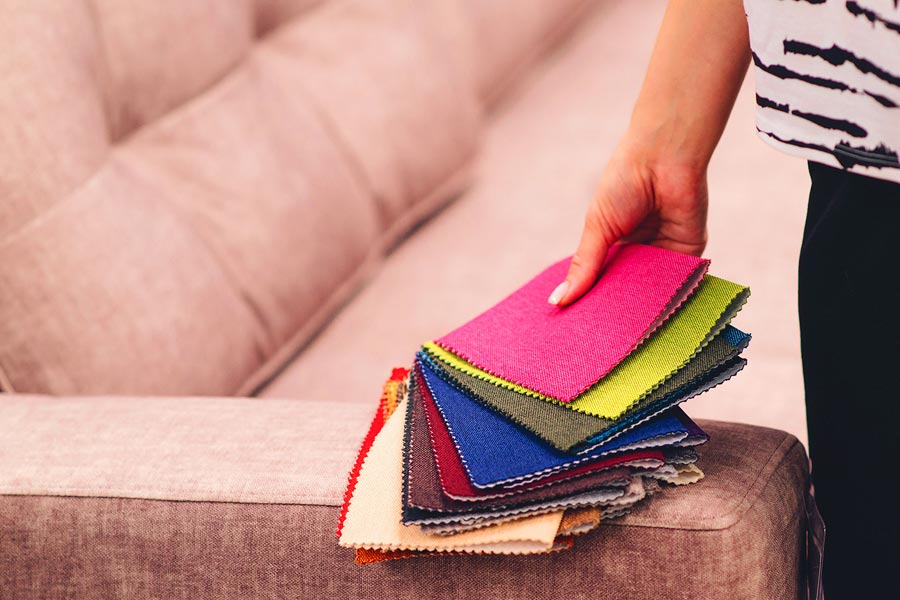
15 May Fabric Fusion: Which Upholstery Textures Complement Each Other Best?
Ah, the art of fabric fusion in upholstery—where the tactile delight of textures meets the eye of design. It’s no small feat to mix and match these elements effectively, but when done right, the result is nothing short of stunning. Whether you’re sprucing up a vintage settee or choosing the upholstery for a brand-new couch, understanding how to blend fabric textures can elevate your interior from mundane to magazine-worthy.
The Role of Texture in Upholstery
Texture in upholstery isn’t just about how a fabric feels; it’s a crucial element that adds depth and dimension to your interiors. It affects how colors look under different lights, how a piece of furniture stands out in a room, and even how it makes you feel when you sink into it after a long day. Introducing the concept of fabric fusion—combining different textures to create a cohesive look—can be your secret weapon in designing a captivating space.
Understanding Fabric Textures
Let’s break down some popular upholstery textures:
- Velvet: Luxurious and soft, velvet adds a touch of sophistication and depth. It’s often used in more formal or opulent settings.
- Linen: Known for its relaxed and breezy vibe, linen is a favorite in casual, airy interiors. Its natural weave offers a light texture that’s perfect for laid-back lounging.
- Tweed: This textured fabric brings a rustic, tactile feel to furnishings, often used in traditional or vintage-inspired designs.
- Leather: Sleek and timeless, leather adds both texture and patina over time, growing richer and more characterful as it ages.
Each of these textures brings its own flavor to the table, making the act of combining them a careful balance of contrast and harmony.
Principles of Combining Textures
When it comes to mixing textures, the principles of balance and contrast are key. Here’s how you can master the mix:
- Balance: Avoid letting one texture dominate. Balance a heavy, textured tweed with something light and airy like linen to keep the visual weight consistent.
- Contrast: Play with contrasting textures to highlight different elements. Pair the smooth, cool touch of leather with the plush, warm feel of velvet for a sensory feast.
The trick is to select textures that complement rather than clash, creating a layered look that feels intentional and inviting.
Popular Combinations and Why They Work
Some texture pairings naturally work well together, thanks to their inherent properties. For instance, linen and leather combine wonderfully—the ruggedness of leather juxtaposed with the softness of linen creates a dynamic duo that’s both visually appealing and practical. Another successful pairing is velvet and tweed; the richness of velvet balances tweed’s more subdued, earthy vibe.
Visualizing the Mix
To truly grasp the impact of these combinations, let’s visualize some successful pairings:
- Imagine a classic chesterfield sofa in rich brown leather, accented with plush velvet cushions in a deep jewel tone. The contrast in textures emphasizes the sofa’s luxurious contours.
- Consider a sleek modern chair upholstered in crisp linen, with a tweed throw pillow for an unexpected rustic touch. The blend not only adds interest but also invites touch and engagement.
These examples show how mixed textures can enhance furniture’s appeal and functionality.
DIY Tips for Fabric Fusion
Feeling inspired? Here’s how you can start experimenting with fabric fusion in your own home:
- Start small with accessories like pillows and throws to test your texture combinations.
- Keep the color palette restrained if you’re mixing several textures, to maintain a cohesive look.
Maintaining Your Textural Trio
Mixed-texture upholstery requires thoughtful care to maintain its beauty. Each material might have its own care needs—velvet might need regular brushing to keep its pile lush, while leather requires conditioning to prevent cracks. Always refer to care labels and consider protective treatments, especially for pieces that see daily use.
Wrapping Up
The fusion of different fabric textures in upholstery is not just about aesthetics; it’s about setting a mood, defining comfort, and adding character to your living space. With thoughtful combinations, you can transform a room into a tactile haven that invites relaxation and conversation.
Your Turn to Experiment
Now that you’ve got the rundown on mixing upholstery textures, why not give it a go? Share your fabric fusion projects with us, or if you’re looking for a bit more guidance, consult with a professional to bring your vision to life. Remember, in the world of interior design, the best results often come from thinking outside the box—or cushion!


